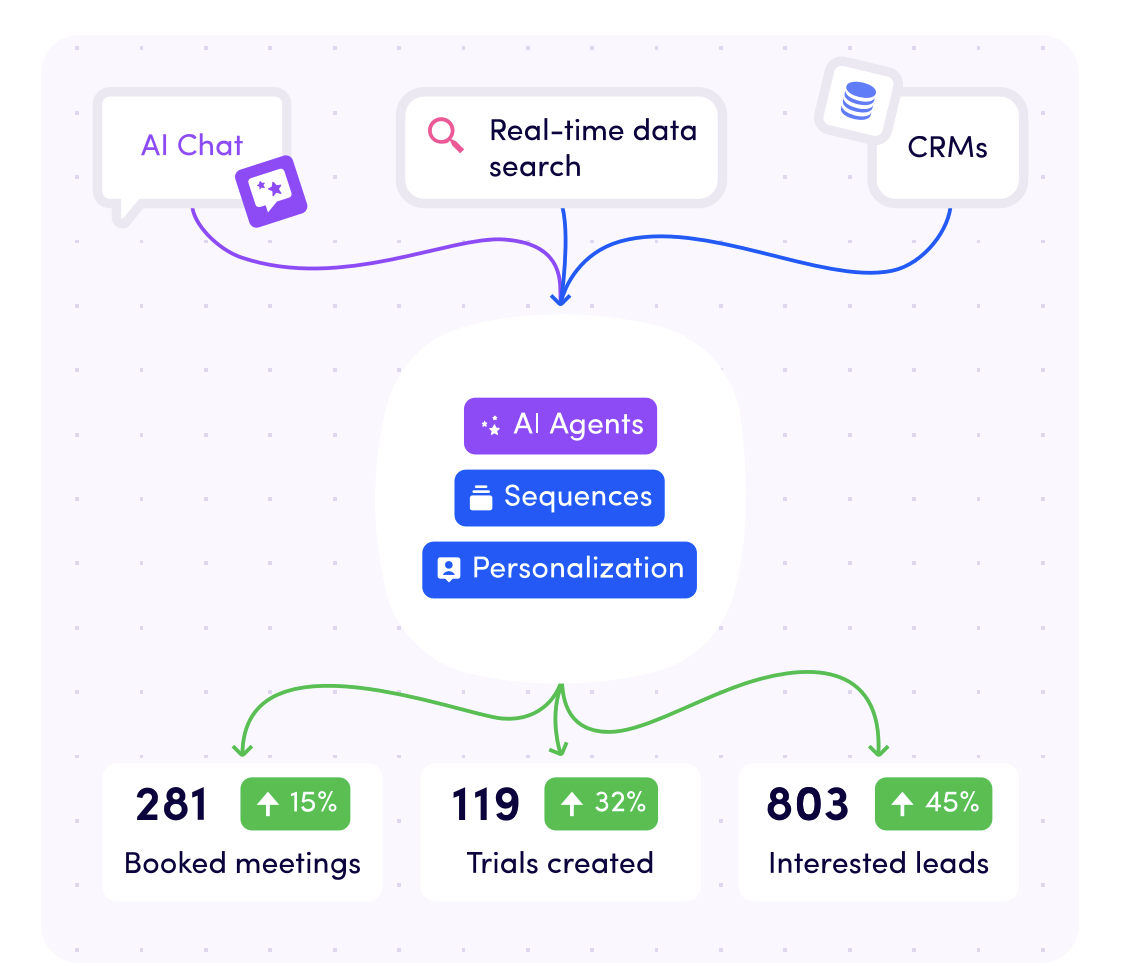The #1 blocker for effective AI adoption

In a world where artificial intelligence (AI) is not just a buzzword but a reality transforming industries, why are so many small and medium-sized enterprises (SMEs) still struggling to reap its benefits?
AI is rapidly becoming a central component of digital transformations, with Generative AI adoption growing across various industries.
Yet, 80% of professionals use Generative AI at work, but 57% of organisations feel unprepared for AI-driven disruption and implementation.
For business leaders eager to navigate this new frontier, understanding the blockers to effective AI adoption is crucial for unlocking AI's full business impact.
Let's take a look at the most common blockers and (what we believe) is the #1 blocker for effective AI adoption.
- Leadership stagnation
- Fear of disruption
- AI Blind spots
- Data gaps
- Skills gap
- Lack of a strategic alignment
- Lack of an innovative culture
- The #1 blocker 👀
Alright, let's take a look at what's holding your company back from effective AI adoption and how you can overcome these challenges!
1. Leadership Stagnation
In the journey towards AI adoption, one of the most formidable barriers is leadership stagnation.
This occurs when those at the helm of an organisation resist change.
When leadership is stuck in the past, the entire company’s progress can come to a grinding halt.
Leadership stagnation isn’t just a minor hurdle—it’s a critical blocker that can cripple your AI ambitions before they even take off.
AI demands a shift not just in technology but in mindset.
Leaders who fail to embrace this shift risk leaving their organisations behind in an increasingly competitive market.
In a world where AI is redefining industries, businesses led by individuals unwilling to adapt will inevitably fall behind.
These leaders may dismiss AI as a passing trend or view it as too complex and ultimately secure the future of their organisations.
💡 Sounds familiar? Here's what you can do
To break free from leadership stagnation, start by fostering a culture of continuous learning and curiosity at the executive level.
Encourage leaders to engage with AI not just as a concept, but through real-world examples and case studies that highlight its tangible benefits.
Organise workshops or attend industry events where leaders can interact with peers who have successfully navigated the AI adoption journey.
This exposure can help shift mindsets from scepticism to advocacy, paving the way for more effective leadership and AI-driven solutions.

2. Fear Of Disruption
The promise of AI is vast, but with it comes a significant concern: fear of disruption.
This fear is rooted in the uncertainty that AI brings, particularly regarding job displacement and sweeping organisational changes.
Many employees and leaders worry that AI, especially in the form of Generative AI and deep learning systems, will disrupt their roles or radically change business processes.
This fear can lead to resistance and prevent AI initiatives from gaining the necessary support.
Employees, and even some leaders, may worry that AI will render their roles obsolete or radically alter their day-to-day work.
This fear can lead to a lack of buy-in for AI initiatives, stalling progress and limiting the organisation’s ability to innovate and compete effectively.
💡 Sounds familiar? Here's what you can do
The key to overcoming the fear of disruption lies in education and transparency. Start by clearly communicating the role of AI in your organisation.
Emphasise how AI is designed to augment human capabilities rather than replace them.
Share examples of how AI can take over mundane, repetitive tasks, allowing employees to focus on more strategic, creative, and fulfilling work.
In addition, involve your team in the AI adoption process.
Offer training sessions that empower employees to understand and use AI tools, making them active participants in the transformation rather than passive observers.

3. AI Blind Spots
When it comes to adopting AI, one of the biggest obstacles is what we call AI blind spots.
These are the areas where your team doesn’t fully understand AI—whether it’s what AI can do, how it works, or where it might fall short.
These blind spots can cause all sorts of problems, from setting unrealistic goals to missing out on AI’s real potential.
Simply put, if you don’t see the whole picture, you’re likely to make mistakes that could cost you time, money, and opportunities.
This not only risks the success of your AI projects but could also make your team lose faith in AI altogether.
💡 Sounds familiar? Here's what you can do
Start with practical education. Organise workshops and seminars that demystify AI and offer real-world applications that can be applied to your business process.
By encouraging continuous learning and engaging with AI experts, your team will gain the necessary insights to avoid blind spots and make informed decisions that align with your broader strategy.

4. Data Gaps
Machine Learning systems and Neural Networks rely on large volumes of high-quality data to function properly.
However, many organisations struggle with data that is incomplete, inaccurate, or inaccessible.
These gaps can severely limit the effectiveness of AI models, leading to poor outcomes and, ultimately, a loss of confidence in the technology.
Data gaps are crucial to address because they directly impact the performance of AI.
If your AI model is fed with poor-quality data, it’s like trying to build a house on a weak foundation—the results will be shaky at best.
Accurate and comprehensive data is what allows AI to make informed decisions, spot patterns, and provide valuable insights.
Without it, even the most advanced AI systems are destined to fail.
💡 Here's what to do to overcome this!
The key to overcoming data gaps is to establish a robust data governance strategy. This involves setting up strict data quality controls to ensure that the data entering your AI systems is accurate, complete, and relevant.
Start by auditing your current data sources to identify any gaps or inconsistencies.
Once these are identified, invest in technologies that help with data cleansing and enrichment, ensuring that your data is in the best possible shape before your AI models use it.
In addition, consider setting up a dedicated team responsible for data management.
This team can regularly monitor data quality, update data governance policies, and ensure that your organisation’s data remains reliable.

5. Skills Gap
Another critical blocker to successful AI adoption is the skills gap.
The demand for AI expertise often outstrips the supply, leaving many organisations struggling to find the talent they need to implement and manage AI initiatives effectively.
This shortage can put companies at a competitive disadvantage, as they may lack the specialised knowledge required to fully leverage AI’s potential.
The skills gap is a significant issue because it directly affects your ability to execute AI projects.
Without the right expertise, even the most well-planned AI strategies can falter.
Whether it’s developing complex algorithms, interpreting AI-driven insights, or maintaining AI systems, having a skilled team is essential to ensuring that your AI initiatives are successful and sustainable.
💡 Check out this AI scan to see how you score on the AI maturity scale.

6. Lack Of A Strategic Alignment
When it comes to AI adoption, one of the most overlooked but critical blockers is a lack of strategic alignment.
Approaching AI without a coherent strategy is like setting off on a journey without a map.
You may have the tools and the destination in mind, but without a clear plan, you’re likely to get lost along the way.
Lack of strategic alignment happens when AI initiatives are pursued in isolation, without a strong connection to the broader business objectives.
This disjointed approach can lead to wasted resources, unmet expectations, and AI projects that fail to deliver meaningful results.
Simply put, if your AI efforts aren’t aligned with your overall business strategy, they’re unlikely to contribute effectively to your organisation’s goals.

7. Lack of an innovative culture
The final, yet equally crucial, blocker to effective AI adoption is the lack of an innovative culture within an organisation.
AI thrives in environments that encourage creativity, experimentation, and a willingness to take risks.
Yet, many organisations are held back by a culture that favours tradition and resists change.
Foster a culture that encourages innovation and exploration. Promote privacy-conscious experimentation with AI, allowing your team to test new ideas and fail forward.
A lack of an innovative culture is particularly problematic because it stifles the very qualities that AI adoption requires:
- Openness to new ideas
- Adaptability
- The courage to explore uncharted territory.
In a stagnant culture, even the most well-conceived AI initiatives can struggle to gain traction, as employees may be reluctant to try new approaches or challenge the status quo.

The #1 blocker - AI Literacy
At the core of all these challenges lies the most significant blocker of all
AI literacy.
Simply put, AI literacy refers to the understanding and knowledge necessary to engage with AI technologies effectively.
Without a strong foundation in AI literacy, organisations are more likely to misinterpret AI’s potential, make poor decisions, or encounter resistance.
This can lead to gaps in privacy management, governance, and alignment with business impact goals.
AI literacy is critical because it underpins every other aspect of AI adoption.
If your team lacks a basic understanding of AI, they’re likely to misinterpret its potential, fear its implications, or fail to align it with your business strategy.
This knowledge gap can lead to poor decision-making, resistance to AI projects, and ultimately, missed opportunities.

How to get started with AI for your business
So, let's get started with it already!
Jumping into AI might seem like a big leap, but it’s more accessible than you’d think.
Here’s a friendly guide to help you get started and make the most out of AI for your business.
Getting started with AI doesn’t need to be overwhelming.
Start with small, manageable projects, experiment with different AI tools, and gradually integrate them into your business operations.
With the right approach, AI can become a powerful ally in driving your business forward.
You can also take a course on AI for business to improve your strategies and get certified on the topic!
Check out this course from Growth Tribe here.
FAQ
Why is AI literacy considered the #1 blocker for AI adoption?
AI literacy is the foundation for all successful AI initiatives. Without a clear understanding of AI’s capabilities, limitations, and applications, organizations are prone to missteps such as setting unrealistic goals, mishandling privacy concerns, or failing to align AI efforts with broader business objectives. Building AI literacy within your organisation ensures that your team can make informed decisions and fully leverage AI’s potential to drive growth and innovation.
How can organisations address the skills gap in AI?
To overcome the AI skills gap, organisations should invest in targeted training programmes to upskill their existing workforces. Additionally, partnering with academic institutions can bring in fresh talent and expertise. In the short term, outsourcing certain AI functions can provide access to necessary skills, helping to keep AI projects on track while internal capabilities are being developed.
What role does high-quality data play in AI adoption?
High-quality data is crucial for the success of AI systems, including **machine learning models**. Data that is accurate, complete, and relevant allows AI to make informed decisions, identify patterns, and provide actionable insights. Addressing data quality issues through a robust data governance strategy is essential to avoid poor outcomes and to build trust in AI's capabilities within your organisation.
How can AI solutions help with cost savings?
AI solutions can significantly contribute to cost savings by automating routine tasks, optimising processes, and improving decision-making. For instance, AI can streamline data processing, enhance risk management, and improve operational efficiency across various sectors. However, the effectiveness of these solutions depends on the availability of high-quality data and a well-trained workforce.
How do privacy regulations impact AI adoption?
Privacy regulations play a critical role in how organisations implement AI. Adhering to these regulations ensures that AI systems handle personal and sensitive data responsibly, maintaining trust with customers and stakeholders. Organisations must be aware of and comply with relevant privacy laws to avoid legal pitfalls and ensure that their AI solutions are both effective and ethical.
What steps can be taken to foster an innovative culture that supports AI adoption?
To create a culture that embraces AI, organisations should encourage experimentation, creativity, and a willingness to explore new ideas. Providing spaces for innovation and recognising those who push boundaries can help cultivate an environment where AI solutions thrive. It’s also important to align these efforts with the company’s strategic goals and ensure that **privacy** and **quality issues** are addressed from the outset.
How can AI enhance risk management within an organisation?
AI can significantly improve **risk management** by processing large amounts of data quickly and identifying potential threats before they become critical. AI-driven **intelligence** allows organisations to make proactive decisions, mitigate risks, and improve overall security. This capability is particularly valuable in sectors where timely and accurate risk assessment is crucial.
Categories
- Business & Innovation (83)
- Growth & Marketing (72)
- Artificial Intelligence (53)
- Data & Analytics (16)
- Case studies (10)
- Project Management (10)
Related articles
Latest articles
AI in Finance: Why You Need It Now
Imagine a world where loans are approved in seconds. Sounds...
ChatGPT Search Unveiled: Should You Make The Switch Now?
Picture this: You’re no longer just “searching” the web—you’re...
Shadow AI Explained: How to Harness Hidden AI Without the Risks
Picture this: your team is under pressure to deliver results—fast....
The 33 best AI tools for commercial teams
The tools are split into 2 categories The best AI tools for your...









